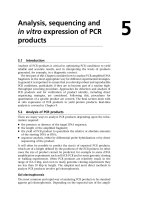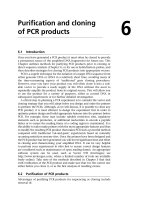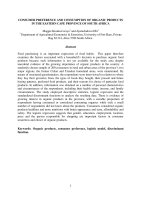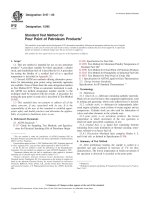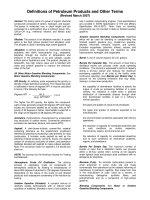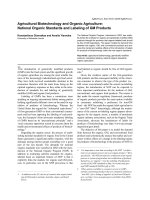Standard Test Method for Ultraviolet Absorbance and Absorptivity of Petroleum Products
Bạn đang xem bản rút gọn của tài liệu. Xem và tải ngay bản đầy đủ của tài liệu tại đây (106.33 KB, 7 trang )
This international standard was developed in accordance with internationally recognized principles on standardization established in the Decision on Principles for the
Development of International Standards, Guides and Recommendations issued by the World Trade Organization Technical Barriers to Trade (TBT) Committee.
Designation: D2008 − 12
Standard Test Method for
Ultraviolet Absorbance and Absorptivity of Petroleum
Products1
This standard is issued under the fixed designation D2008; the number immediately following the designation indicates the year of
original adoption or, in the case of revision, the year of last revision. A number in parentheses indicates the year of last reapproval. A
superscript epsilon (´) indicates an editorial change since the last revision or reapproval.
2. Referenced Documents
1. Scope*
1.1 This test method covers the measurement of the ultraviolet absorption of a variety of petroleum products. It covers
the absorbance of liquids or the absorptivity of liquids and
solids, or both, at wavelengths in the region from 220 to
400 nm of the spectrum.
1.2 The use of this test method implies that the conditions of
measurement—wavelength, solvent (if any), sample path
length, and sample concentration—are specified by reference
to one of the examples of the application of this test method in
the annexes or by a statement of other conditions of measurement.
1.3 Examples of the application of this test method are the
absorptivity of refined petroleum wax, and the absorptivity of
USP petrolatum.
1.4 The values stated in SI units are to be regarded as the
standard. The values stated in Fahrenheit, feet, and inches,
indicated in parentheses, are for information only.
1.5 Warning—Mercury has been designated by EPA and
many state agencies as a hazardous material that can cause
central nervous system, kidney, and liver damage. Mercury, or
its vapor, may be hazardous to health and corrosive to
materials. Caution should be taken when handling mercury and
mercury-containing products. See the applicable product Material Safety Data Sheet (MSDS) for details and EPA’s website
( for additional information. Users should be aware that selling mercury or mercurycontaining products, or both, in your state may be prohibited by
state law.
1.6 This standard does not purport to address all of the
safety concerns, if any, associated with its use. It is the
responsibility of the user of this standard to establish appropriate safety and health practices and determine the applicability of regulatory limitations prior to use. For specific
warning statements, see 7.3.1, 7.3.3, and 13.4.
1
This test method is under the jurisdiction of ASTM Committee D02 on
Petroleum Products and Lubricants and is the direct responsibility of Subcommittee
D02.04.0F on Absorption Spectroscopic Methods.
Current edition approved June 1, 2012. Published October 2012. Originally
approved in 1962. Last previous edition approved in 2009 as D2008–09. DOI:
10.1520/D2008-12.
2.1 ASTM Standards:2
D1193 Specification for Reagent Water
E131 Terminology Relating to Molecular Spectroscopy
E169 Practices for General Techniques of Ultraviolet-Visible
Quantitative Analysis
E275 Practice for Describing and Measuring Performance of
Ultraviolet and Visible Spectrophotometers
3. Terminology
3.1 Definitions of terms and symbols relating to absorption
spectroscopy in this test method shall conform to Terminology
E131. Terms of particular significance are the following:
3.2 Definitions:
3.2.1 radiant energy, n—energy transmitted as electromagnetic waves.
3.2.2 radiant power, P, n—the rate at which energy is
transported in a beam of radiant energy.
3.2.3 transmittance, T, n—the molecular property of a substance that determines its transportability of radiant power,
expressed by:
T5
P
Po
(1)
where:
P = the radiant power passing through the sample and
Po = the radiant power incident upon the sample.
3.2.4 absorbance, A, n—the molecular property of a substance that determines its ability to take up radiant power,
expressed by:
A 5 log10 ~ 1/T ! 5 2log10T
(2)
where T is the transmittance as defined in 3.2.3.
3.2.4.1 Discussion—Absorbance expresses the excess absorption over that of a specified reference or standard. It is
implied that compensation has been affected for reflectance
2
For referenced ASTM standards, visit the ASTM website, www.astm.org, or
contact ASTM Customer Service at For Annual Book of ASTM
Standards volume information, refer to the standard’s Document Summary page on
the ASTM website.
*A Summary of Changes section appears at the end of this standard
Copyright © ASTM International, 100 Barr Harbor Drive, PO Box C700, West Conshohocken, PA 19428-2959. United States
Copyright by ASTM Int'l (all rights reserved); Tue Nov 21 07:51:49 EST 2017
1
Downloaded/printed by
Nanyang Technological University (Nanyang Technological University) pursuant to License Agreement. No further reproductions authorized.
D2008 − 12
losses, solvent absorption losses, and refractive effects, if
present, and that attenuation by scattering is small compared
with attenuation by absorption.
3.2.5 dilution factor, f, n—the proportion of solvent increase
made to reduce the concentration and thus the absorbance of a
solute, expressed by the ratio of the volume of the diluted
solution to the volume of original solution containing the same
quantity of solute as the diluted solution.
3.2.6 absorptivity, a, n—the specific property of a substance
to absorb radiant power per unit sample concentration and path
length, expressed by:
a 5 Af/bc
(3)
where:
A = the absorbance defined in 3.2.4,
f = the dilution factor defined in 3.2.5,
b = sample cell path length, and
c = the quantity of absorbing substance contained in a
volume of solvent.
3.3 Definitions of Terms Specific to This Standard:
3.3.1 sample cell pathlength, b, n—the distance in
centimetres, measured in the direction of propagation of the
beam of radiant energy, between the surface of the specimen on
which the radiant energy is incident and the surface of the
specimen from which it is emergent.
3.3.1.1 Discussion—This distance does not include the
thickness of the cell in which the specimen is contained.
3.3.2 concentration, c, n—the quantity of absorbing substance in grams per litre.
4. Summary of Test Method
4.1 The ultraviolet absorbance of a liquid is determined by
measuring the absorption spectrum of the undiluted liquid in a
cell of known path length under specified conditions.
4.2 The ultraviolet absorptivity of a solid or a liquid is
determined by measuring the absorbance, at specified
wavelengths, of a solution of the liquid or solid at known
concentration in a cell of known path length.
5. Significance and Use
5.1 The absorbance of liquids and the absorptivity of liquid
and solids at specified wavelengths in the ultraviolet are useful
in characterizing petroleum products.
6. Apparatus
6.1 Spectrophotometer, equipped to handle liquid samples in
cells having sample path lengths up to 10 cm and capable of
measuring absorbance in the spectral region from 220 to
400 nm with a spectral slit width of 2 nm or less. Wavelength
measurement shall be repeatable and known to be accurate
within 60.2 nm or less as measured by the mercury emission
line at 313.16 nm or the absorption spectrum of either holmium
oxide glass at 287.5 nm or holmium oxide solution at 287.1
nm. At the 0.4 absorbance level in the spectral region between
220 and 400 nm, absorbance measurements shall be repeatable
within 61.0 %.
6.2 For recommended methods of testing spectrophotometers to be used in this test method, refer to Practice E275.
6.3 An instrument is considered suitable when it can be
operated in a manner to give test results equivalent to those
described in 6.1.
6.4 Measurements requiring the use of cells having sample
path lengths less than 10 cm can be made on instruments
equipped to handle only these cells. It is desirable, but not
essential, that the instrument be automatic recording when an
extended range of the spectrum must be examined. Manually
operated spectrometers are suitable for obtaining absorbance
readings at specified analytical wavelengths. If measurements
are to be made at temperatures higher than room temperature,
the spectrophotometer must be provided with a means for
maintaining cells at the selected test temperature.
6.5 One or more pairs of fused silica cells having sample
path lengths in the range from 0.1000 to 10.00 cm are required.
Sample path lengths must be known to within 60.5 % of
nominal sample path length or better. Unless otherwise
specified, 1-cm sample path length cells are recommended.
Suitable procedures for testing and cleaning cells are described
in Practice E275.
7. Reagents and Materials
7.1 Purity of Reagents—Reagent grade chemicals shall be
used in all tests. Unless otherwise indicated, it is intended that
all reagents shall conform to the specifications of the Committee on Analytical Reagents of the American Chemical Society,
where such specifications are available.3 Other grades may be
used, provided it is first ascertained that the reagent is of
sufficiently high purity to permit its use without lessening the
accuracy of the determination.
7.2 Purity of Water—Unless otherwise indicated, references
to water shall be understood to mean reagent water conforming
to Specification D1193, Type III.
7.3 Solvents:
7.3.1 Isooctane—(Warning—Extremely flammable, harmful if inhaled.), for use as the preferred spectroscopic solvent.
7.3.2 Technical isooctane is a satisfactory base stock for the
preparation of spectroscopic solvent. Allow about 4 or 5 L of
this material to percolate through a column of activated silica
gel 50 to 75 mm (2 to 3 in.) in diameter and 0.6 to 0.9 m (2 to
3 ft) in depth. Collect only the portion of the solvent that has
an absorbance less than 0.05 over the entire spectral range from
240 to 300 nm in a 1-cm cell when compared to water in a
1-cm cell.
7.3.3 Decahydronaphthalene (Decalin)—(Warning—
Combustible, vapors harmful.), for use as the first alternative
spectroscopic solvent.
3
Reagent Chemicals, American Chemical Society Specifications, American
Chemical Society, Washington, DC. For Suggestions on the testing of reagents not
listed by the American Chemical Society, see Annual Standards for Laboratory
Chemicals, BDH Ltd., Poole, Dorset, U.K., and the United States Pharmacopeia
and National Formulary, U.S. Pharmacopeial Convention, Inc. (USPC), Rockville,
MD.
Copyright by ASTM Int'l (all rights reserved); Tue Nov 21 07:51:49 EST 2017
2
Downloaded/printed by
Nanyang Technological University (Nanyang Technological University) pursuant to License Agreement. No further reproductions authorized.
D2008 − 12
7.3.4 The silica gel percolation described in 7.3.2 is also
recommended for the preparation of decahydronaphthalene as
a spectroscopic solvent.
7.3.5 Some common, commercially available solvents of
“spectroscopic purity” are listed in Practices E169. One of
them can be selected for use in absorptivity measurements but
only when indicated in Section 13.
7.4 Holmium Oxide Glass or Holmium Oxide Solution—
Used to verify the wavelength accuracy of the spectrophotometer.
the 0.1-cm cell. Record these values only as greater than 1.0. If
numerical values are required it is recommended that absorptivity be measured rather than absorbance.
9.4 Repeat 9.1 and 9.2 using a 0.1-cm cell, or a 0.5-cm cell
when appropriate, in place of the 1.0-cm cell (9.3). Record all
measurements.
10. Calculation
10.1 Calculate the absorbance of an undiluted liquid sample
at each analytical wavelength as follows:
8. Sampling
8.1 Precautions must be taken to ensure that a representative
sample is obtained since ultraviolet absorption is very sensitive
to small amounts of extraneous material contaminating the
sample through careless handling. If possible, samples should
be obtained from packaged products that have been protected
from accidental contamination.
8.2 If the petroleum product to be tested is available as a
bulk sample weighing more than 1 kg, a representative sample
of approximately 1 kg shall be taken and made homogeneous.
8.3 If the petroleum product to be tested is available as a
bulk sample weighing less than 1 kg but more than 100 g, the
entire sample shall be taken and made homogeneous.
8.4 In no case shall a sample of a petroleum product be
considered representative if it weighs less than 100 g.
However, measurements may be made on samples weighing
less than 100 g if the origin, sampling procedure, and basis of
selection of the sample are recorded and reported as part of the
results of this test method.
A 5 AL 2 AC
(4)
where:
A = absorbance of undiluted liquid sample,
AL = chart or absorbance reading of sample-filled sample
cell, and
AC = chart or absorbance reading of water-filled sample cell.
10.2 Calculate the absorbance per centimetre path length
that is equal to A/b, where b is the sample cell path length in
centimetres.
11. Report
11.1 If the numerical value of the absorbance of an undiluted liquid sample is reported, accompany it with a statement
of the wavelength of measurement and the sample path length
expressed in centimetres.
11.2 If the numerical value of the absorbance per centimetre
of an undiluted liquid sample is reported, it must accompany it
with a statement of the wavelength of measurement.
ABSORBANCE OF UNDILUTED LIQUIDS
ABSORPTIVITY OF SOLIDS AND LIQUIDS
9. Procedure
9.1 Fill a 1.0-cm reference cell with water. Make sure the
cell windows are clean. Position the cells in the cell compartment of the spectrophotometer and obtain absorbance at the
wavelengths of interest within the range from 220 to 400 nm.
This data gives a cell correction for the 1.0-cm cell. It can be
ignored at all wavelengths where the absorbance is between
−0.01 and +0.01. After the cell correction data has been
determined, the cells shall be designated reference and sample
cells and shall be maintained as such.
9.2 Fill a 1.0-cm sample cell with undiluted liquid sample
(after complete removal of water) and obtain the absorbance as
described in 9.1.
9.3 The absorbance-wavelength curve can be conveniently
obtained starting at the long wavelength end of the spectrum.
Take readings at successively shorter wavelengths until an
absorbance greater than 1.0 is obtained. When using automatic
recording instruments (recommended) make the cell correction
scan and the sample scan on the same chart. In the longer
wavelength region of the spectrum, it may be desirable to use
longer path length cells than those recommended to obtain
readable absorbances. See the applicable paragraph of Practices E169. In the shorter wavelength region of the spectrum,
absorbances can become too high for accurate measurement in
12. Summary of Test Methods
12.1 The range of absorptivities for petroleum products can
be very wide. Probably most absorptivities of interest would
fall in the range from 10−4 to 10 L/g·cm.
12.2 In determining absorptivities it is necessary to measure
absorbances in the range from 0.1 to 1.0 for optimum results.
This is done by preparing solutions and selecting cells of
sample path length to give absorbances in the 0.1 to 1.0 range.
For an individual petroleum product the absorptivity may
change so rapidly with wavelength that it is necessary to
prepare several solutions in order to cover the required
wavelength interval. Consideration must be given to the
selection of solvent, the selection of concentration levels, and
the selection of sample paths lengths to obtain optimum results.
13. Selection of Solvent
13.1 Refer to the applicable section of Practices E169 for a
brief discussion of solvents for ultraviolet use. The choice of
solvent is dictated by the solubility of the petroleum product
and the transparency of the solvent in the region of interest.
13.2 Use isooctane unless restricted by solubility requirements.
Copyright by ASTM Int'l (all rights reserved); Tue Nov 21 07:51:49 EST 2017
3
Downloaded/printed by
Nanyang Technological University (Nanyang Technological University) pursuant to License Agreement. No further reproductions authorized.
D2008 − 12
13.3 Use decahydronaphthalene as the first alternative solvent to be used if the sample is not sufficiently soluble in
isooctane.
from 2.5 to 100. Select dilution factors to obtain an absorbance
reading in the range from 0.1 to 1.0 at the wavelength of
measurement.
13.4 If neither isooctane nor decahydronaphthalene will
dissolve a sufficient quantity of sample to prepare the required
solution, then one of the solvents listed in the table in Practices
E169. As indicated in the table in Practices E169, not all of
these solvents are usable over the entire spectral range covered
by this test method. For the purposes of this test method a
solvent shall be considered to have sufficient “spectroscopic
purity” when its absorbance in a 1-cm cell, using reagent water
in a 1-cm cell as a reference, is less than 0.05 at all wavelengths
where a sample absorbance is to be measured in a 1-cm cell.
Cyclohexane (Warning—Extremely flammable. Harmful if
inhaled.), carbon tetrachloride, chloroform (Warning— Carbon tetrachloride and chloroform can be fatal if swallowed.
Harmful if inhaled. Can produce toxic vapors if burned.), and
the alcohols listed in the table in Practices E169 are useful
alternative spectroscopic solvents.
NOTE 1—For example, 1 mL of the initial solution (4 g/L) pipetted into
a 25-mL volumetric flask, which is then filled to the mark with solvent and
shaken, will give a dilution factor of 25 and a concentration level of
0.160 g/L in the first dilution. Repeating this procedure on the first dilution
would produce a second dilution containing 0.0064 g/L. The dilution
factor for the second dilution would be 625.
14. Selection of Solution Concentration
14.1 Select an initial concentration of the sample high
enough to provide measurable absorbance (0.1 to 1.0) at the
wavelength of weakest absorption to be measured but not over
40 g/L and necessarily within the solubility limitations of the
solvent.
14.2 The lowest concentration that can be prepared conveniently in the initial solution is about 1 g/L. If the sample is not
sufficiently soluble at room temperature to prepare such a
solution, then proceed at elevated temperature in accordance
with Section 16.
14.3 Table 1 lists four recommended concentration levels
for the initial solution and the required sample weights and
solution volumes. Column 4 gives the range of absorptivities
that will give absorbance readings between 0.1 and 1.0 when
the solution is measured in a 1-cm cell.
14.4 Select from Table 1 the concentration required to
measure the lowest absorptivity of interest in the sample. Note
the recommended sample weights and solution volumes. These
shall be used in preparing the initial solution of the sample.
14.5 If concentration levels lower than 1 g/L are required
because absorptivities at the wavelengths of interest exceed 1,
prepare an initial solution at the 4 g/L level (Table 1) and dilute
as follows: pipet 1 to 10 mL of the initial solution into a 25 to
100-mL volumetric flask to obtain a dilution factor in the range
TABLE 1 Recommended Sample Weights and Solution Volumes
for Initial Solution of Sample
Concentration, Sample Weight,
g/L
mgA
40
10
4
1
1000
250
100
100
Volumetric
Flask, mL
25
25
25
100
Range of Absorptivities
Measurable in 1-cm CellB
0.0025
0.010
0.025
0.100
to 0.0250
to 0.100
to 0.250
to 1.000
A
The sample should be weighed to the nearest 0.1 mg and be within ±5 % of the
nominal weight listed.
B
If a 10-cm cell were used, the range of absorptivities measurable would be
lowered by a factor of 10.
15. Selection of Sample Path Length
15.1 Unless otherwise specified in a particular application
of this test method, use a sample path length of 1.0 cm, and the
alternative sample path length of 10.0 cm.
15.2 The procedures given in Sections 16 and 17 were
written assuming the use of the recommended sample path
length, 1 cm, and the use of the alternative sample path length,
10.0 cm. If in a particular application of this test method
different sample path lengths are specified, the smaller shall
become the recommended sample path length and shall be used
where a 1.0-cm cell is specified. The larger shall become the
alternative sample path length and shall be used where a
10.0-cm cell is specified.
16. Procedure at Room Temperature
16.1 Weigh by difference the recommended sample weight
into the volumetric flask (see Table 1). Add solvent to partially
fill the flask and shake to dissolve the sample. Fill to the mark
with solvent. Mix well.
16.2 If sample does not go into solution rapidly, warm the
solution by heating the flask under warm tap water. When the
sample has dissolved, dilute to volume and shake to make
homogeneous. Cool to room temperature. Add solvent to the
mark.
16.3 Fill a 1.0-cm sample cell with the initial solution or
dilution to be measured. Fill a 1.0-cm reference cell with
solvent. Make sure the windows are clean. Position the cell in
the cell compartment of spectrophotometer and measure the
absorbance of the sample at wavelengths of interest within the
range from 220 to 400 nm.
16.4 If the absorbance reading in the 1.0-cm cell is less than
0.1 at one or more of the wavelengths of interest, repeat 16.3
using a pair of 10-cm cells to obtain an absorbance reading in
the 0.1 to 1.0 range.
16.5 If the absorbance reading in the 1.0-cm cell is greater
than 1.0 at one or more of the wavelengths of interest, dilute to
obtain absorbances in the readable range (0.1 to 1.0). Dilution
factors of 2.5 to 100 can be obtained by pipetting volumes of
1 to 10 mL of the initial solution into 25 to 100-mL volumetric
flasks and filling to the mark with solvent.
16.6 Determine the cell correction by measuring the absorbance of the solvent-filled sample cell compared to the
solvent-filled reference cell.
17. Procedure at Elevated Temperature
17.1 If it is not possible to obtain a homogeneous solution of
the sample at room temperature in the recommended solvents
Copyright by ASTM Int'l (all rights reserved); Tue Nov 21 07:51:49 EST 2017
4
Downloaded/printed by
Nanyang Technological University (Nanyang Technological University) pursuant to License Agreement. No further reproductions authorized.
D2008 − 12
(16.2), it will be permissible to determine the absorbance at a
test temperature high enough to ensure solubility. However, do
not exceed 66°C (150°F).
17.2 Weigh by difference the recommended sample weight
into a clean, calibrated volumetric flask and record the weight
to the nearest 0.1 mg (see Table 1).
17.3 Partially fill the flask with solvent, and place the flask
in a water bath at the test temperature. When the sample is
completely dissolved, dilute to volume using solvent at the test
temperature. Shake to make homogeneous and bring to the test
temperature in a water bath.
17.4 Prepare spectrophotometer cell holders capable of
maintaining the sample cell and reference cell at the desired
test temperature.
17.5 Take proper precautions to ensure that the temperature
of the solution at the time of absorbance measurement is within
61.1°C (2°F) of the test temperature at which the solution was
diluted to volume.
17.6 Transfer a sample of the solution (hypodermic syringe
heated to the test temperature is convenient) into a 1.0-cm
sample cell previously heated to the test temperature. Fill a
1.0-cm reference cell with solvent at the test temperature in a
similar manner. Stopper the cells firmly. Make sure the cell
windows are clean. Position the cells in the cell compartment
of the spectrophotometer. Allow enough time for temperature
equilibrium and obtain the absorbance as required at wavelengths of interest within the range from 220 to 400 nm.
17.7 If the absorbance reading in the 1.0-cm cell is less than
0.1 at one or more of the wavelengths of interest, repeat 17.6
using a pair of 10-cm cells to obtain an absorbance reading in
the 0.1 to 1.0 range.
17.8 If the absorbance reading in the 1.0-cm cell is greater
than 1.0 at one or more of the wavelengths of interest, prepare
a second initial solution at a lower concentration level selected
from Table 1. If this is not possible, repeat 17.6 using a pair of
0.1 or 0.5-cm cells to obtain an absorbance reading in the 0.1
to 1.0 range. Record all readings.
17.9 Determine a cell correction by using solvent in the
sample cell and compare it to the solvent-filled reference cell.
18. Calculation
18.1 Calculate the absorptivity, a, of a solid or liquid sample
at the specified wavelength as follows:
a 5 Af/cb
(5)
where:
A = absorbance of sample solution at specified wavelength
minus cell correction,
b = path length of sample cell in centimetres,
c = concentration of sample in grams per litre of the initial
solution, and
f
= dilution factor, the ratio of the volume of the diluted
solution to the volume of the original solution containing the same quantity of solute as the diluted solution.
For the initial solution, f = 1.
19. Report
19.1 Report numerical values of absorptivities along with a
statement of the wavelength, solvent, concentration, and cell
path length used in obtaining the absorbance measurement.
20. Precision and Bias
20.1 Precision—The precision for four specific petroleum
products are given in 9 through 11 (for white mineral oil), in
A1.5 (for refined petroleum wax), in A2.5 (for USP
petrolatum), and in A3.5 (for nonstaining rubber processing or
extender oils).
20.2 The precision for other petroleum products should be
determined by cooperative testing on representative types of
such other petroleum products.
20.3 Bias—Bias cannot be determined for these procedures
since there are no acceptable reference standards.
21. Keywords
21.1 petroleum products; ultraviolet absorbance; ultraviolet
absorptivity; ultraviolet spectroscopy
ANNEXES
(Mandatory Information)
A1. ABSORPTIVITY OF REFINED PETROLEUM WAX
A1.1 Scope
A1.1.1 As an example of the application of the general
method for determining the absorptivity of solids and liquids,
the absorptivity of refined petroleum wax is determined at
290 nm. Under the conditions specified, this method covers the
determination of absorptivities in the range from 0.01 to
1.0 L/g·cm.
Copyright by ASTM Int'l (all rights reserved); Tue Nov 21 07:51:49 EST 2017
5
Downloaded/printed by
Nanyang Technological University (Nanyang Technological University) pursuant to License Agreement. No further reproductions authorized.
D2008 − 12
A1.2 Procedure
A1.5 Precision and Bias
A1.2.1 Follow the general method given in Section 15 for
determining absorptivity at room temperature. The recommended sample weight shall be 100 mg dissolved in 100 mL of
isooctane.4 Make absorbance measurements at 290 nm in 1.0
and 10.0-cm cells as described in Section 16.
A1.5.1 The precision of the method as obtained by statistical examination of interlaboratory test results is as follows:
A1.5.1.1 Repeatability—The difference between successive
test results obtained by the same operator with the same
apparatus under constant operating conditions on identical test
material, would in the long run, in the normal and correct
operation of the test method, exceed the values shown in the
following table only in one case in twenty.
A1.2.2 If the sample is not sufficiently soluble in isooctane,
use the alternative solvent decahydronaphthalene.
A1.2.3 If the sample is not sufficiently soluble at room
temperature in either isooctane or decahydronaphthalene, continue as described in Section 17.
A1.3 Calculation
A1.3.1 The absorptivity, a, of a wax is given in Eq 5.
A1.4 Report
A1.4.1 Report the absorptivities of waxes in the range from
0.01 to 1.0 to two significant figures. Report absorptivities less
than 0.01 as less than 0.01. Report absorptivities greater than
1.0 as greater than 1.0.
4
In the ASTM Emergency Method ES-50, Test for Ultraviolet Absorptivity of
Waxes, the recommended sample weight was 57 to 67 mg dissolved in 50 mL of
isooctane. See 1961 Book of ASTM Standards, Part 7, p. 1357.
Absorptivity
0.02
0.15
0.30
Repeatability
...
0.02
0.02
A1.5.1.2 Reproducibility—The difference between two
single and independent results, obtained by different operators
working in different laboratories on identical test material,
would in the long run, in the normal and correct operation of
the test method, exceed the values shown in the following table
only in one case in twenty.
Absorptivity
0.02
0.15
0.30
Reproducibility
...
0.05
0.05
A1.5.2 Bias—Bias cannot be determined for this procedure
since there is no acceptable reference standard.
A2. ABSORPTIVITY OF USP PETROLATUM
A2.1 Scope
A2.1.1 As an example of the application of the general
method for determining the absorptivity of solids and liquids,
the absorptivity of USP petrolatum shall be determined at 290
nm. Under the conditions specified, this method covers the
determination of absorptivities in the range from 0.02 to 5.0
L/g·cm.
A2.4 Report
A2.2 Procedure
A2.2.1 Follow the general method given in Section 15 for
determining absorptivity at room temperature. The recommended sample weight shall be 100 mg dissolved in 100 mL of
isooctane. Absorbance measurements shall be made at 290 nm
in 1.0 and 10.0-cm cells as described in Section 16. If a dilution
is required as described in 16.5, a dilution factor of 5 (5 to
25 mL) will be adequate for measuring absorptivities up to 5.0.
A2.2.2 If the sample is not sufficiently soluble in isooctane,
the alternative solvent decahydronaphthalene shall be used.
A2.5.1 The precision of the method as obtained by statistical examination of interlaboratory test results is as follows:
A2.5.1.1 Repeatability—The difference between successive
test results, obtained by the same operator with the same
apparatus under constant operating conditions on identical test
material, would in the long run, in the normal and correct
operation of the test method, exceed 0.01 at the level of 0.5
only in one case in twenty.
A2.5.1.2 Reproducibility—The difference between two
single and independent results, obtained by different operators
working in different laboratories on identical test material,
would in the long run, in the normal and correct operation of
the test method, exceed 0.05 at the level of 0.5 only in one case
in twenty.
NOTE A2.1—Carbon tetrachloride (Warning—Can be fatal if swallowed. Harmful if inhaled. Can produce toxic vapors if burned.) is a good
solvent for many petrolatums and can be used when the sample is not
sufficiently soluble in decahydronaphthalene.
A2.3 Calculation
A2.3.1 The absorptivity of the petrolatum at 290 nm is
given in Eq 5.
A2.4.1 Report absorptivities of petrolatums in the range
from 0.02 to 5.0 to two significant figures. Report absorptivities less than 0.02 as less than 0.02. Report absorptivities
greater than 5.0 as greater than 5.0.
A2.5 Precision and Bias
A2.5.2 Bias—Bias cannot be determined for this procedure
since there is no acceptable reference standard.
Copyright by ASTM Int'l (all rights reserved); Tue Nov 21 07:51:49 EST 2017
6
Downloaded/printed by
Nanyang Technological University (Nanyang Technological University) pursuant to License Agreement. No further reproductions authorized.
D2008 − 12
A3. NONSTAINING RUBBER PROCESSING OR EXTENDER OILS
A3.1 Scope
A3.4 Report
A3.1.1 As an example of the application of the general
procedure for determining the absorptivity of solids and
liquids, the absorptivity of nonstaining rubber extender and
processing oils is determined at 260 nm. Under the conditions
specified, this method determines the absorptivities in the
range from 0.10 to 20 L/g·cm.
A3.4.1 Report absorptivities of oils in the range from 0.10
to 20 to two significant figures. Report absorptivities less than
0.10 as less than 0.10. Report absorptivities greater than 20 as
greater than 20.
A3.5 Precision and Bias
NOTE A3.1—The precision for this test was not obtained in accordance
with RR:D02-1007.
A3.2 Procedure
A3.2.1 Follow the general procedure of Section 16 for
determining absorptivity at room temperature. The recommended sample weight is 100 mg dissolved in 100 mL of
“spectro grade” isooctane. Make absorbance measurements at
260 nm in a 1.0-cm cell as described in Section 16.
A3.2.2 If dilution is required by 16.5, a dilution factor of 5
(5 to 25 mL) will be adequate for measuring absorptivities up
to 5.0; a dilution factor of 20 (5 to 100 mL) will be adequate
for measuring absorptivities between 5.0 and 20.0.
A3.3 Calculation
A3.3.1 The absorptivity of the oil at 260 nm is in Eq 5.
A3.5.1 The following criteria should be used for judging the
acceptability of results (95 % confidence):
A3.5.1.1 Repeatability—Duplicate results by the same operator should be considered suspect if they differ by more than
7 % of the mean.
A3.5.1.2 Reproducibility—The results submitted by each of
two laboratories should be considered suspect if they differ by
more than 9 % of the mean.
A3.5.2 Bias—Bias cannot be determined for this procedure
since there is no acceptable reference standard.
SUMMARY OF CHANGES
Subcommittee D02.04 has identified the location of selected changes to this standard since the last issue
(D2008–09) that may impact the use of this standard.
(1) Revised 1.3 and 9.4.
(2) Deleted original Annex A1 and renumbered the remaining
annexes.
ASTM International takes no position respecting the validity of any patent rights asserted in connection with any item mentioned
in this standard. Users of this standard are expressly advised that determination of the validity of any such patent rights, and the risk
of infringement of such rights, are entirely their own responsibility.
This standard is subject to revision at any time by the responsible technical committee and must be reviewed every five years and
if not revised, either reapproved or withdrawn. Your comments are invited either for revision of this standard or for additional standards
and should be addressed to ASTM International Headquarters. Your comments will receive careful consideration at a meeting of the
responsible technical committee, which you may attend. If you feel that your comments have not received a fair hearing you should
make your views known to the ASTM Committee on Standards, at the address shown below.
This standard is copyrighted by ASTM International, 100 Barr Harbor Drive, PO Box C700, West Conshohocken, PA 19428-2959,
United States. Individual reprints (single or multiple copies) of this standard may be obtained by contacting ASTM at the above
address or at 610-832-9585 (phone), 610-832-9555 (fax), or (e-mail); or through the ASTM website
(www.astm.org). Permission rights to photocopy the standard may also be secured from the ASTM website (www.astm.org/
COPYRIGHT/).
Copyright by ASTM Int'l (all rights reserved); Tue Nov 21 07:51:49 EST 2017
7
Downloaded/printed by
Nanyang Technological University (Nanyang Technological University) pursuant to License Agreement. No further reproductions authorized.
